Marketing automation has become an essential tool for businesses seeking to streamline their marketing processes, improve efficiency, and drive growth. When implemented correctly, it can transform your marketing efforts, leading to increased conversions, improved customer engagement, and a significant boost in return on investment. This comprehensive guide will explore five powerful tips for flawless marketing automation implementation, helping you navigate the complexities and maximize the benefits of this innovative technology.
Understanding the Importance of Marketing Automation Implementation
Before diving into the tips, it’s crucial to grasp the significance of marketing automation implementation. This process involves integrating software platforms and technologies designed to automate repetitive marketing tasks, personalize customer interactions, and analyze marketing performance. When executed properly, marketing automation can revolutionize your marketing strategies, allowing you to reach the right audience with the right message at the right time.
Benefits of marketing automation extend far beyond simple task automation. They include improved lead generation and nurturing, enhanced customer segmentation, personalized customer experiences, and data-driven decision-making. By leveraging these advantages, businesses can create more effective marketing campaigns, increase productivity, and ultimately drive revenue growth.
Now, let’s explore the five essential tips for successful marketing automation implementation.
Tip 1: Define Clear Goals and Strategy
The foundation of any successful marketing automation implementation lies in setting clear, measurable goals and developing a comprehensive strategy. Without a well-defined roadmap, your automation efforts may lack direction and fail to deliver the desired results.
Establish SMART Goals
Start by setting Specific, Measurable, Achievable, Relevant, and Time-bound (SMART) goals for your marketing automation initiative. These goals should align with your overall business objectives and address key performance indicators (KPIs) such as:
- Lead generation and conversion rates
- Customer acquisition costs
- Customer lifetime value
- Revenue growth
- Marketing ROI
Develop a Comprehensive Strategy
Once you’ve established your goals, create a detailed strategy that outlines how marketing automation will help you achieve them. Your strategy should include:
- Target audience identification and segmentation
- Customer journey mapping
- Content creation and distribution plans
- Integration with existing systems and processes
- Performance measurement and optimization tactics
By defining clear goals and a robust strategy, you’ll set the stage for a successful marketing automation implementation that drives tangible results for your business.
Tip 2: Choose the Right Marketing Automation Platform
Selecting the appropriate marketing automation platform is crucial for the success of your implementation. With numerous options available, it’s essential to carefully evaluate your needs and choose a solution that aligns with your goals, budget, and technical requirements.
Key Factors to Consider
When evaluating marketing automation platforms, consider the following factors:
- Scalability: Ensure the platform can grow with your business and handle increasing volumes of data and campaigns.
- Integration capabilities: Look for solutions that integrate seamlessly with your existing CRM, e-commerce, and other business systems.
- User-friendliness: Choose a platform with an intuitive interface that your team can quickly learn and utilize effectively.
- Features and functionality: Assess whether the platform offers the specific features you need, such as email marketing, lead scoring, and analytics.
- Support and training: Consider the level of customer support and training resources provided by the vendor.
- Pricing structure: Evaluate the cost-effectiveness of the platform, including any hidden fees or additional charges for advanced features.
Comparison Table of Popular Marketing Automation Platforms
| Platform | Key Features | Integration Capabilities | Pricing Model | Best For |
|---|---|---|---|---|
| HubSpot | All-in-one marketing suite, CRM, email marketing, lead nurturing | Extensive third-party integrations | Tiered pricing based on contacts | Small to medium-sized businesses |
| Marketo | Advanced lead management, account-based marketing, revenue attribution | Strong integration with Salesforce | Quote-based pricing | Large enterprises, B2B companies |
| Mailchimp | Email marketing, landing pages, audience insights | Good integration with e-commerce platforms | Tiered pricing based on contacts and features | Small businesses, e-commerce |
| Pardot | B2B marketing automation, lead nurturing, ROI reporting | Native Salesforce integration | Tiered pricing based on features | B2B companies using Salesforce |
| ActiveCampaign | Email marketing, CRM, sales automation | Wide range of integrations | Tiered pricing based on contacts and features | Small to medium-sized businesses |
By carefully evaluating your options and selecting the right platform, you’ll set a solid foundation for your marketing automation implementation.
Tip 3: Prioritize Data Quality and Management

The success of your marketing automation implementation heavily relies on the quality and management of your data. Clean, accurate, and well-organized data is essential for effective segmentation, personalization, and campaign execution.
Implement Data Cleansing Processes
Regularly cleanse your data to ensure its accuracy and relevance:
- Remove duplicate entries
- Update outdated information
- Standardize data formats
- Verify contact information
- Remove inactive or unengaged contacts
Establish Data Governance Policies
Create clear guidelines for data collection, storage, and usage:
- Define data ownership and responsibilities
- Implement data security measures
- Establish data retention policies
- Ensure compliance with data protection regulations (e.g., GDPR, CCPA)
- Create protocols for data entry and maintenance
Leverage Data Integration and Enrichment
Enhance your data quality through integration and enrichment:
- Integrate data from multiple sources (CRM, website, social media)
- Use third-party data enrichment services to fill gaps in customer profiles
- Implement progressive profiling to gather additional information over time
- Utilize behavioral data to enhance customer insights
By prioritizing data quality and management, you’ll ensure that your marketing automation efforts are built on a solid foundation of accurate and actionable information.
Tip 4: Develop a Comprehensive Content Strategy
Content is the fuel that powers your marketing automation engine. A well-planned content strategy ensures that you deliver relevant, valuable information to your audience at every stage of the customer journey.
Map Content to the Customer Journey
Create content that addresses the needs and pain points of your audience at each stage of the buying process:
- Awareness: Educational blog posts, infographics, and social media content
- Consideration: Whitepapers, case studies, and product comparison guides
- Decision: Product demos, free trials, and customer testimonials
- Retention: How-to guides, webinars, and exclusive content for existing customers
Implement Content Personalization
Leverage your marketing automation platform’s personalization capabilities to deliver tailored content experiences:
- Use dynamic content blocks to customize email messages
- Create personalized landing pages based on user behavior or attributes
- Implement smart content on your website that adapts to visitor characteristics
- Utilize behavioral triggers to send targeted content recommendations
Establish a Content Calendar
Develop a content calendar that aligns with your marketing automation campaigns:
- Plan content creation and distribution in advance
- Ensure a consistent flow of content across various channels
- Coordinate content with seasonal trends and industry events
- Allow for flexibility to respond to emerging trends or opportunities
By developing a comprehensive content strategy, you’ll ensure that your marketing automation efforts are supported by high-quality, relevant content that resonates with your target audience.
Tip 5: Implement, Test, and Optimize Continuously
Marketing automation implementation is an ongoing process that requires continuous refinement and optimization. To maximize the effectiveness of your efforts, it’s crucial to adopt a culture of testing, learning, and improvement.
Start with Pilot Campaigns
Begin your implementation with small-scale pilot campaigns:
- Choose a specific segment or product line for initial automation
- Test different automation workflows and campaign structures
- Gather data and insights to inform broader implementation
Conduct Regular A/B Testing
Continuously test and optimize various elements of your marketing automation:
- Email subject lines, content, and design
- Landing page layouts and copy
- Call-to-action buttons and placement
- Automation workflow triggers and timing
Monitor and Analyze Performance Metrics
Regularly review key performance indicators to assess the effectiveness of your marketing automation:
- Email open and click-through rates
- Conversion rates at different stages of the funnel
- Lead quality and scoring accuracy
- Revenue attribution and ROI
Refine and Optimize Based on Insights
Use the data and insights gathered to continuously improve your marketing automation:
- Adjust segmentation criteria based on performance data
- Refine lead scoring models to improve accuracy
- Optimize automation workflows for better engagement and conversions
- Update content based on user engagement and feedback
By adopting a mindset of continuous improvement, you’ll ensure that your marketing automation implementation remains effective and aligned with your business goals over time.
Conclusion:
Implementing marketing automation is a transformative journey that can significantly enhance your marketing efforts and drive business growth. By following these five powerful tips – defining clear goals and strategies, choosing the right platform, prioritizing data quality, developing a comprehensive content strategy, and continuously optimizing your efforts – you’ll be well-positioned for success in your marketing automation implementation.
Remember that marketing automation strategies should be tailored to your specific business needs and goals. As you embark on this journey, consider seeking guidance from marketing automation consulting experts who can provide valuable insights and help you navigate potential challenges.
For businesses in the online retail space, exploring eCommerce marketing automation can unlock new opportunities for growth and customer engagement. By leveraging automation to personalize the shopping experience, streamline order fulfillment, and nurture customer relationships, you can create a competitive advantage in the digital marketplace.
As you progress in your implementation, keep in mind that adhering to marketing automation best practices is crucial for long-term success. Stay informed about industry trends, emerging technologies, and evolving customer expectations to ensure your automation efforts remain effective and relevant.
Ultimately, the success of your marketing automation implementation will be measured by its impact on your business objectives. By focusing on marketing automation ROI, you can demonstrate the value of your efforts and secure ongoing support for your initiatives.
Whether you choose to implement marketing automation in-house or partner with a marketing automation agency, the key to success lies in a strategic, data-driven approach that prioritizes customer needs and business goals. By following these tips and remaining committed to continuous improvement, you’ll be well on your way to achieving flawless marketing automation implementation and reaping the rewards of this powerful technology.
FAQs
Some important steps before implementing marketing automation include:
- Define your goals and success metrics clearly
- Audit existing marketing technology and processes
- Get buy-in from all stakeholders across the organization
- Build customer journeys for each persona
- Integrate with your CRM, analytics systems, etc.
- Start with an MVP approach focused on quick wins
To ensure smooth adoption:
- Provide adequate training to employees on using the system
- Have on-floor support to resolve issues in early stages
- Highlight benefits and wins through internal communications
- Gradually build more capabilities after initial successes
- Involve employees early on to secure their buy-in
Key benefits to highlight include:
- Increased efficiency through process automation
- Enhanced productivity of marketing teams
- Better lead nurturing and sales readiness
- More personalized and consistent customer experiences
- Higher conversion rates and faster sales cycle
- Improved marketing ROI and lowered costs
- Competitive advantage and growth opportunities
Key parameters to track success include:
- Lead generation, quality and conversion rates
- Sales cycle length, deal sizes
- Email open, click through and engagement rates
- Campaign ROI and revenue contribution
- Customer satisfaction and retention rates
- Marketing team productivity
- Adoption across customer touchpoints
Some best practices include:
- Take an iterative approach – start small, test, learn and expand
- Ensure tight integration between marketing automation and other systems
- Clean up your existing customer data for accuracy
- Build workflows aligned closely to buyer journeys
- Provide extensive training and ramp-up support to users
- Review programs regularly and tweak based on data insights
Some pitfalls to avoid:
- Setting vague objectives without measurable outcomes
- Viewing marketing automation in isolation vs. part of a unified CX strategy
- Not having enough quality data, content and integrations
- Trying to automate too much too soon vs. adopting a phased approach
- Lack of continuous optimization based on reporting and analytics
- Inadequate training and internal capabilities to leverage the platform
 Anas is our go-to copywriter with a knack for crafting persuasive and high-converting eCommerce landing pages. His passion for words and understanding of consumer psychology helps turn visitors into loyal customers. When he's not refining his copy, Anas enjoys exploring the latest digital marketing trends and experimenting with new writing techniques. His blend of creativity and strategic thinking makes him an indispensable part of our energetic team.
Anas is our go-to copywriter with a knack for crafting persuasive and high-converting eCommerce landing pages. His passion for words and understanding of consumer psychology helps turn visitors into loyal customers. When he's not refining his copy, Anas enjoys exploring the latest digital marketing trends and experimenting with new writing techniques. His blend of creativity and strategic thinking makes him an indispensable part of our energetic team.












